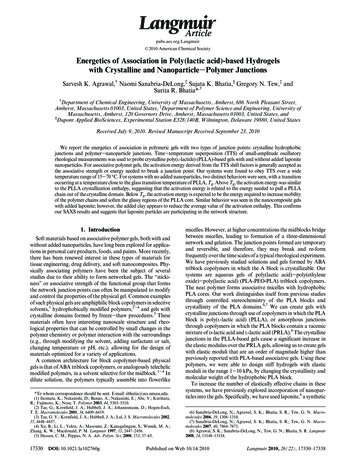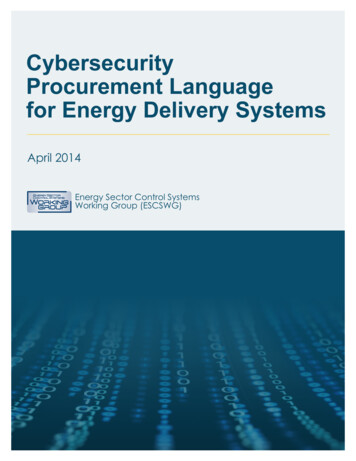
Transcription
pubs.acs.org/Langmuir 2010 American Chemical SocietyEnergetics of Association in Poly(lactic acid)-based Hydrogelswith Crystalline and Nanoparticle-Polymer JunctionsSarvesh K. Agrawal,† Naomi Sanabria-DeLong,‡ Sujata K. Bhatia,§ Gregory N. Tew,‡ andSurita R. Bhatia*,††Department of Chemical Engineering, University of Massachusetts, Amherst, 686 North Pleasant Street,Amherst, Massachusetts 01003, United States, ‡Department of Polymer Science and Engineering, University ofMassachusetts, Amherst, 120 Governors Drive, Amherst, Massachusetts 01003, United States, and§Dupont Applied BioSciences, Experimental Station E328/140B, Wilmington, Delaware 19880, United StatesReceived July 9, 2010. Revised Manuscript Received September 23, 2010We report the energetics of association in polymeric gels with two types of junction points: crystalline hydrophobicjunctions and polymer-nanoparticle junctions. Time-temperature superposition (TTS) of small-amplitude oscillatoryrheological measurements was used to probe crystalline poly(L-lactide) (PLLA)-based gels with and without added laponitenanoparticles. For associative polymer gels, the activation energy derived from the TTS shift factors is generally accepted asthe associative strength or energy needed to break a junction point. Our systems were found to obey TTS over a widetemperature range of 15-70 C. For systems with no added nanoparticles, two distinct behaviors were seen, with a transitionoccurring at a temperature close to the glass transition temperature of PLLA, Tg. Above Tg, the activation energy was similarto the PLLA crystallization enthalpy, suggesting that the activation energy is related to the energy needed to pull a PLLAchain out of the crystalline domain. Below Tg, the activation energy is expected to be the energy required to increase mobilityof the polymer chains and soften the glassy regions of the PLLA core. Similar behavior was seen in the nanocomposite gelswith added laponite; however, the added clay appears to reduce the average value of the activation enthalpy. This confirmsour SAXS results and suggests that laponite particles are participating in the network structure.1. IntroductionSoft materials based on associative polymer gels, both with andwithout added nanoparticles, have long been explored for applications in personal care products, foods, and paints. More recently,there has been renewed interest in these types of materials fortissue engineering, drug delivery, and soft nanocomposites. Physically associating polymers have been the subject of severalstudies due to their ability to form networked gels. The “stickiness” or associative strength of the functional group that formsthe network junction points can often be manipulated to modifyand control the properties of the physical gel. Common examplesof such physical gels are amphiphilic block copolymers in selectivesolvents,1 hydrophobically modified polymers,2-4 and gels withcrystalline domains formed by freeze-thaw procedures.5 Thesematerials often have interesting nanoscale structure and rheological properties that can be controlled by small changes in thepolymer chemistry or polymer interaction with the surroundings(e.g., through modifying the solvent, adding surfactant or salt,changing temperature or pH, etc.), allowing for the design ofmaterials optimized for a variety of applications.A common architecture for block copolymer-based physicalgels is that of ABA triblock copolymers, or analogously telechelicmodified polymers, in a solvent selective for the midblock.1-4 Indilute solution, the polymers typically assemble into flowerlike*To whom correspondence should be sent. E-mail: sbhatia@ecs.umass.edu.(1) Inomata, K.; Nakanishi, D.; Banno, A.; Nakanishi, E.; Abe, Y.; Kurihara,R.; Fujimoto, K.; Nose, T. Polymer 2003, 44, 5303–5310.(2) Tae, G.; Kornfield, J. A.; Hubbell, J. A.; Johannsmann, D.; Hogen-Esch,T. E. Macromolecules 2001, 34, 6409–6419.(3) Tae, G. Y.; Kornfield, J. A.; Hubbell, J. A.; Lal, J. S. Macromolecules 2002,35, 4448–4457.(4) Xu, B.; Li, L.; Yekta, A.; Masoumi, Z.; Kanagalingam, S.; Winnik, M. A.;Zhang, K. W.; Macdonald, P. M. Langmuir 1997, 13, 2447–2456.(5) Hassan, C. M.; Peppas, N. A. Adv. Polym. Sci. 2000, 153, 37–65.17330 DOI: 10.1021/la102760gmicelles. However, at higher concentrations the midblocks bridgebetween micelles, leading to formation of a three-dimensionalnetwork and gelation. The junction points formed are temporaryand reversible, and therefore, they may break and re-formfrequently over the time scales of a typical rheological experiment.We have previously studied solutions and gels formed by ABAtriblock copolymers in which the A block is crystallizable. Oursystems are aqueous gels of poly(lactic acid)-poly(ethyleneoxide)-poly(lactic acid) (PLA-PEO-PLA) triblock copolymers.The neat polymer forms associative micelles with hydrophobicPLA cores. Our work distinguishes itself from previous studiesthrough controlled stereochemistry of the PLA blocks andcrystallinity of the PLA domains.6,7 We can create gels withcrystalline junctions through use of copolymers in which the PLAblock is poly(L-lactic acid) (PLLA), or amorphous junctionsthrough copolymers in which the PLA blocks contain a racemicmixture of D-lactic acid and L-lactic acid (PRLA).6 The crystallinejunctions in the PLLA-based gels cause a significant increase inthe elastic modulus over the PRLA gels, allowing us to create gelswith elastic moduli that are an order of magnitude higher thanpreviously reported with PLA-based associative gels. Using thesepolymers, we were able to design stiff hydrogels with elasticmoduli in the range 1-10 kPa, by changing the crystallinity andmolecular weight of the hydrophobic PLA block.To increase the number of elastically effective chains in thesesystems, we have previously explored incorporation of nanoparticles into the gels. Specifically, we have used laponite,8 a synthetic(6) Sanabria-DeLong, N.; Agrawal, S. K.; Bhatia, S. R.; Tew, G. N. Macromolecules 2006, 39, 1308–1310.(7) Sanabria-DeLong, N.; Agrawal, S. K.; Bhatia, S. R.; Tew, G. N. Macromolecules 2007, 40, 7864–7873.(8) Agrawal, S. K.; Sanabria-DeLong, N.; Tew, G. N.; Bhatia, S. R. Langmuir2008, 24, 13148–13154.Published on Web 10/14/2010Langmuir 2010, 26(22), 17330–17338
Agrawal et al.ArticleTable 1. Characteristics of PLA-PEO-PLA Triblock CopolymersSynthesizedsampleDPPLLADPPEOMn (kDa)66 L71 L89 L66718920220220213.513.915.2polymer melts, it has also been applied to block copolymers1,10-13and polymer nanocomposites14,15 in the presence of a solvent. Inthe present work we have studied the temperature dependence ofthe rheological behavior of gels formed by PLLA-PEO-PLLAtriblock copolymers in water, both with and without added nanoparticles (Figure 1). In these systems PLLA is crystalline and thusthe junctions formed in the gels by PLLA are crystalline innature.6 The rheological data for the gels at different temperatureswas found to obey TTS by shifting the data along the frequencyaxis to yield master curves that could be used to predict therheological behavior of the gels over very small frequencies orvery long time scales. We use these data to understand the activation enthalpies of junction points in the hydrogels. Furthermore,TTS has been performed on PLLA-PEO-PLLA hydrogels withadded laponite and the activation enthalpies obtained for thesesystems have been compared with that for the neat polymer gels.2. Materials and Methods2.1. Materials. L-Lactide ((3S)-cis-3,6-dimethyl-1,4-dioxane2,5-dione)) from Aldrich was purified by recrystallization in ethylacetate and then sublimated prior to polymerization. The R,ωdihydroxypolyethylene glycol macroinitiator with molecularweight 8000 g/mol (PEG 8K, Aldrich) was dried at room temperature under vacuum for 2 days prior to polymerization. MALDI(matrix assisted laser desorption/ionization) and GPC (gel permeation chromatography) showed this polymer to be 8900 g/molin weight. Stannous(II) 2-ethylhexanoate (Alfa Aesar) was usedwithout further purification. Laponite XLG used in this study wasobtained from Southern Clay Products, Inc. (Gonzales, TX, U.S.).2.2. Synthesis of PLLA-PEO-PLLA Triblock Copolymer. Solution-synthesized PLLA-PEO-PLLA copolymers wereFigure 1. Schematic of PLLA-PEO-PLLA triblocks forming associative disklike micelles with crystalline PLLA cores and PEOcoronas, and addition of laponite particles that adsorb PEO chainsand form additional polymer-particle junction points.disk-shaped clay that is roughly 1 nm thick and 25 nm in diameter.PEO chains are known to adsorb strongly onto the surface oflaponite particles. Thus, the resulting gels have both PLLA-basedhydrophobic junctions and PEO-clay junctions. The gels containing laponite show an enhanced elastic modulus with verysmall amounts of added solid.8 SAXS measurements confirm thatthe clays are participating in the polymer network and not merelyacting as fillers in the system.Time-temperature superposition (TTS) has frequently beenused to obtain information about the rheological behavior ofmaterials at conditions outside the measurement range of a conventional rheometer.9 Although the most commonly known useof time-temperature superposition is investigation of dynamics in(9) Baumgartel, M.; Willenbacher, N. Rheol. Acta 1996, 35, 168–185.Langmuir 2010, 26(22), 17330–17338prepared as previously reported.7 Telechelic PEO macroinitiatorwas weighed into a dry three-neck round-bottom flask with a stirbar and attached to a condenser. The PEO was stirred and heatedat 130 C under a nitrogen flow. Tin(II) 2-ethylhexanoate wasadded to the PEO, followed by immediate addition of lactide. Thecondenser was turned on, and toluene was added to the reactionmixture. The mixture was refluxed for 24 h under nitrogen flow,then diluted with THF, and precipitated using hexanes. The recovered precipiate was dried under vacuum at room temperature.The polydispersity indeces were typically less than or equal to 1.1as compared to those for narrow polystyrene standards using N,N-dimethylformamide (0.01 M LiCl) at 50 C as the eluent.The polymers used in our study are listed in Table 1, whereDPPLLA is the total degree of polymerization of PLLA (both endblocks), DPPEO is the degree of polymerization of the PEO midblock, and Mn is the number-average molecular weight of the entiretriblock in kDa. The sample names indicate the total length ofPLA block followed by a letter indicating the stereospecificity ofPLA block; e.g., 58 L refers to the polymer PLA29PEO202PLA29,(10) Soenen, H.; Berghmans, H.; Winter, H. H.; Overbergh, N. Polymer 1997,38, 5653–5660.(11) Thunga, M.; Staudinger, U.; Satapathy, B. K.; Weidisch, R.; Abdel-Goad,M.; Janke, A.; Knoll, K. J. Polym. Sci. B, Polym. Phys. 2006, 44, 2776–2788.(12) Castelletto, V.; Hamley, I. W.; Yuan, X. F.; Kelarakis, A.; Booth, C. SoftMatter 2005, 1, 138–145.(13) Rosati, D.; Van Loon, B.; Navard, P. Polymer 2000, 41, 367–375.(14) Daga, V. K.; Wagner, N. J. Rheol. Acta 2006, 45, 813–824.(15) Castelletto, V.; Ansari, I. A.; Hamley, I. W. Macromolecules 2003, 36, 1694–1700.DOI: 10.1021/la102760g17331
ArticleAgrawal et al.which is made using semicrystalline PLLA blocks. The gelsprepared by addition of laponite nanoparticle solution to thepolymers have been referred to as nanoparticle-reinforced gelsin this study. Since the same concentration of laponite solution(2 wt %) was added to all the polymers to make a 25 wt % gel, thenanoparticle reinforced gels have been named individually as“polymer sample name þ lap.” For example at 58 Lþlap refersto a nanoparticle-reinforced 58 L gel.2.3. Rheology. PLLA-PEO-PLLA hydrogels were preparedby simple addition of a known quantity of nanopure water to thepolymer to prepare a 25 wt % dispersion of the polymer in water.For preparing the nanoparticle-reinforced hydrogels, a dispersionof laponite in water was first prepared for addition to the polymer.Laponite XLG clay was added to nanopure water to make a2 wt % dispersion. The system was then homogenized in a T25Basic Ultra-Turrax homogenizer for 2 min until the lumps ofclay at the bottom of the vial broke and dispersed completely inwater, eventually forming a clear, homogeneous, and stabledispersion. The dispersion was then kept at equilibrium for abouthalf an hour before addition to the hydrogel. This process wasfollowed to ensure that we could get good exfoliation of clay.Hydrogels were prepared by slow addition of the laponite dispersion to a measured amount of dried polymer sample to makesamples with total concentration of solids, defined asws ¼mðpolynmerÞ þ mðlaponiteÞmðpolynmerÞ þ mðlaponiteÞ þ mðwaterÞ 100fixed at 25 wt %ð1ÞAll the hydrogel samples were kept at equilibrium for 1 day atroom temperature and then heated at 80 C for 20 h. The gels wereagain allowed to sit for 2-4 days. The final gels obtained weremacroscopically homogeneous and translucent in appearance.For rheology, gels were transferred to a TA InstrumentsAR2000 stress-controlled rheometer. Rheological measurementswere performed using the cone and plate geometry (40 mmdiameter cone with a 2 cone angle). To prevent the evaporationof water, a layer of corn oil was applied to surround the gels on theoutside and in the gap between the cone and the plate. Anotherphysical solvent trap was also used to cover the cone-plateassembly and water evaporation was not found to be significantfor the temperatures and time scales investigated. Frequencysweep tests over a frequency range 0.01-100 Hz, were done atconstant strain amplitudes of 0.1% to measure G0 and G00 (storageand loss moduli, respectively) at all the temperatures investigated.We know from our previous rheology experiments that thematerial behavior remains in the linear viscoelastic regime at thesmall strain amplitudes of 0.1%, at which we probe the gels. Adynamic time sweep test at a strain amplitude of 0.1% andfrequency of 1 Hz, was performed on the gels before eachfrequency scan to ensure that the gel systems have reachedequilibrium. Also, after initial loading, the samples were allowedto equilibrate for 20-30 min before starting any tests to avoid anyeffects of shear during sample loading. The IRIS rheology platform (IRIS Development, LLC) was used to aid in performing theTTS analysis of the rheology data. While the original experimentswere performed with the frequency in hertz, in performing theTTS analysis using IRIS we converted the frequency units to rad/s.2.4. Small Angle X-ray Scattering. SAXS measurementswere performed on the hydrogels on a Molecular MetrologySAXS instrument in the W. M. Keck Nanostructures Laboratoryat UMass Amherst. The instrument generates X-rays with awavelength of λ 1.54 Å and 2-D multiwire detector with asample to detector distance of 1.5 m. The same hydrogel samplesas that used for rheology were used for SAXS characterization.The gel samples used for SAXS experiments were sandwichedbetween kapton films and this enclosed in an airtight sampleholder. This assembly was then put in the X-ray beam path, andthe data were collected on the samples for 30 min.17332 DOI: 10.1021/la102760g3. Results and DiscussionPrevious studies have shown that TTS can be performed onpolymer melts and solution systems for which there are no temperature dependent structural changes or phase transitions in thesystem over the temperature range where TTS is performed.16This has been found to be possible for polymer melts and/oramorphous single component polymer systems away from theglass transition temperature of the system.16,17 However, for morecomplex systems such as solutions and gels of block copolymers,TTS is frequently not possible due to morphological transitionsand/or changes in polymer-solvent interactions with temperature. In particular, in physically gelling polymer systems, the physicalprocesses that lead to junction formation in the gels evolve withtime, because of which rheological measurements for such systemsat very low frequencies or long time scales cannot be performed.Below, we report the rheological response of PLLA-PEOPLLA triblock copolymer gels in water, which behaves as a goodsolvent for PEO and a nonsolvent for PLA, at temperaturesranging from 15 to 70 C. In these systems the PLLA blocks aresemicrystalline and, therefore, gelation in these copolymer systems occurs because of crystallization of the PLA block inaddition to phase separation of the hydrophobic PLA blocks toform micellar aggregates. The latter reason is more commonly thecause of aggregation and gelation in ABA triblock copolymers ina solvent compatible for mid B block.18-21 We have shown inearlier publications22,23 that because of the presence of crystallinePLLA domains forming the network junction points in the gel,these systems form stiff gels and do not show a power-lawterminal relaxation behavior at low frequencies, as is commonlyseen for associative network gels.4,18,19,24,25 Instead, these systemsshow a viscoelastic solid-like behavior with G0 and G00 displaying arelationship G0 G00 ωn over the entire frequency range. Such arelationship between the elastic and loss modulus is characteristicof dynamic mechanical behavior of a system at the gel point andhas been seen previously for other physically gelling systems withcrystalline physical junctions.26,27 The power law frequencydependence of these gels shows that the junctions formed by thesepolymers do not relax over the time scales of the experiment andhave a long lifetime, giving the appearance of “permanent”junctions formed by chemically cross-linked systems.To determine the effect of temperature on the nanoscalemorphology of the PLLA-PEO-PLLA hydrogels, we performedsmall-angle X-ray scattering experiments on 25 wt % gels of thesepolymers. The scattering spectra for 71 L and 71 L þ lap systemsat different temperatures are shown in Figure 2. For clarity,spectra at higher temperatures have been shifted in intensity.We have shown previously that these systems form nonspherical(16) Ferry, J. D. Viscoelastic Properties of Polymers, 3rd ed.; Wiley: New York, 1980.(17) Plazek, D. J. J. Phys. Chem. 1965, 69, 3480–3487.(18) Annable, T.; Buscall, R.; Ettelaie, R.; Whittlestone, D. J. Rheol. 1993, 37,695–726.(19) Tanaka, F.; Edwards, S. F. Macromolecules 1992, 25, 1516–1523.(20) Semenov, A. N.; Joanny, J. F.; Khokhlov, A. R. Macromolecules 1995, 28,1066–1075.(21) Serero, Y.; Aznar, R.; Porte, G.; Berret, J. F.; Calvet, D.; Collet, A.;Viguier, M. Phys. Rev. Lett. 1998, 81, 5584–5587.(22) Aamer, K. A.; Sardinha, H.; Tew, G. N.; Bhatia, S. R. Biomaterials 2004,25, 1087–1093.(23) Agrawal, S. K.; Sanabria-DeLong, N.; Tew, G. N.; Bhatia, S. R. J. Mater.Res. 2006, 21, 2118–2125.(24) Misra, S.; Nguyenmisra, M.; Mattice, W. L. Macromolecules 1994, 27,5037–5042.(25) Xu, B.; Yekta, A.; Li, L.; Masoumi, Z.; Winnik, M. A. Colloids Surf. A:Physicochem. Eng. Aspects 1996, 112, 239–250.(26) Lin, Y. G.; Mallin, D. T.; Chien, J. C. W.; Winter, H. H. Macromolecules1991, 24, 850–854.(27) Richtering, H. W.; Gagnon, K. D.; Lenz, R. W.; Fuller, R. C.; Winter,H. H. Macromolecules 1992, 25, 2429–2433.Langmuir 2010, 26(22), 17330–17338
Agrawal et al.ArticleFigure 2. SAXS spectra for (a) 71 L hydrogel sample and (b) 71 Lþ lap hydrogel sample, obtained at temperatures ranging from 25to 80 C. No changes in micellar assembly or structure occur overthis temperature range. For clarity, the scattered intensities havebeen shifted by factors of 2 (45 and 40 C data), 5 (55 and 50 C data),10 (65 and 60 C data), and 20 (80 and 75 C data). Without thisshifting, the spectra overlap completely (not shown), again reflecting no change in the micellar structure with temperature.“disk-like” micelles (Figure 1), with the PLLA blocks forming acrystalline core and PEO chains attached on the faces of PLLAdisks forming the corona.28,29 The random orientation of thesedisk-like aggregates may lead to smearing of any peaks in thespectra, which is what we see in Figure 2. Gelation in these systemsoccurs due to bridging between the aggregates caused by the twohydrophobic PLLA blocks on the same polymer chain attaching toPLLA cores of different aggregates. Figure 2 shows that the scattering spectra of the 71 L and 71 L þ lap gels at temperaturesranging from 25 to 80 C are nearly indistinguishable. Withoutshifting data at higher temperatures, the spectra overlap nearlyperfectly (not shown). This demonstrates that the PLLA-PEOPLLA systems do not show any significant change in the nanoscalemorphology with increase in temperature and the three-dimensional network of the gel formed by crystalline PLLA junctionsremains preserved. We observed the same behavior for otherpolymer gels having a different molecular weight of the PLLAblock (data not shown).Since the structure of the gels was found to be invariant uponchange in temperature, TTS could be applicable to these materials.(28) Agrawal, S. K.; Sanabria-DeLong, N.; Jemian, P. R.; Tew, G. N.; Bhatia,S. R. Langmuir 2007, 23, 5039–5044.(29) Agrawal, S. K.; Sanabria-DeLong, N.; Tew, G. N.; Bhatia, S. R. Macromolecules 2008, 41, 1774–1784.Langmuir 2010, 26(22), 17330–17338Figure 3. TTS master curves for hydrogels of (a) 66 L, (b) 71 L,and (c) 89 L polymers, with no added nanoparticles. TTS curveshave a reference temperature of 25 C.Frequency sweeps, measured isothermally at different temperatures, were superposed onto a master curve by shifting the curvesin the x (frequency) direction through multiplication with a temperature dependent shift factor at, to obtain final master curveswith a reference temperature of 25 C. Master curves obtained for66 L, 71 L, and 89 L systems are shown in Figure 3. The superposition was done by matching the high frequency range of G0 tothat for the next lower temperature. As can be seen from Figure 3,the G0 data overlap very well for the entire range of temperaturesDOI: 10.1021/la102760g17333
ArticleAgrawal et al.Table 2. Values of Power Law Exponent n for PLLA-PEO-PLLA Hydrogels Obtained by Fitting the TTS Master Curve Data and ActivationEnthalpies Calculated from the Temperature Dependence of the Frequency Shift Factors to eq 2asamplen(G0 )n(G00 )ΔHapp1 (kJ/mol)ΔHapp1 (J/g)ΔHapp2 (kJ/mol)ΔHapp2 (J/g)66 L0.061 ( 0.0030.065 ( 0.003280 ( 3059 ( 5440 ( 3093 ( 571 L0.054 ( 0.0030.060 ( 0.003240 ( 1047 ( 2610 ( 30119 ( 689 L0.042 ( 0.0020.042 ( 0.002380 ( 3060 ( 5480 ( 2075 ( 4aActivation enthalpies in J/g are computed by dividing values in kJ/mol by the total molecular weight of the PLLA block used. Errors reported in fittedparameters are based on experimental uncertainty in the rheological measurements of 5% and on the uncertainty derived from the goodness-of-fit.and frequencies. The G00 data show some deviation from themaster curve at higher frequencies. Similar TTS behavior has beenobserved in several types of physical gels, including thermoreversible gels based on poly(2-vinylpyridine)-poly(ethyl acrylate)poly(2-vinyl pyridine)/poly(4-hydroxylsytrene) in ionic liquids,30borax-cross-linked polysaccharide gels,31 and associative gels ofpolyhedral oligomeric silesquioxane (POSS)-containing copolymers.32 In our system, since this effect was seen for all threepolymer gels and did not seem to vary with changes in temperature, we believe that it may be due to instrument effects or possiblydue to some slippage of the gels during the rheological tests at highfrequency. Interestingly, the final TTS master curves obtained forall the samples show the dependence G0 G00 ωn over the entirefrequency range. The values for the power law exponent (n)obtained upon fitting the curves are shown in Table 2 and arefound to be very low and in the range 0.04-0.06, indicating thatthe PLLA-PEO-PLLA hydrogel systems behave as stiff viscoelastic solids.33Another distinctive feature of the TTS curves obtained for thevarious hydrogel systems is that using this method we are able toobtain combined rheological information about these systems foralmost 11 decades in frequency whereas a traditional rheologicalmeasurement gives us information about the rheological properties of a system for only 3-4 decades in frequency. The mastercurves also provide us information about the behavior of thesystem under small stress at very long time scales corresponding tosmall frequencies. We see that the hydrogels display a viscoelasticsolidlike behavior with G0 G00 ωn and G0 . G00 even at verysmall frequencies, which correspond to long time scales, eventhough they tend to soften with time leading to a decrease in theirelastic modulus value. This information is particularly importantfor possible applications of these materials as cell scaffolds for softtissue engineering, since it shows that these materials remainstable under a small constant stress for very long periods of time.The decrease in the elastic modulus of the polymer gels withincreasing temperature can be ascribed to the glass transition andmelting of the PLLA core and is discussed below.In analyzing our data via TTS, we deliberately chose to superpose the data by only applying a horizontal shift factor, setting thevertical shift factor to unity. Because the data follow a power lawdependence over a large frequency range, it is easy to see thatsuperposition could also be achieved with both a horizontal andvertical shift. Classical theories of the linear viscoelasticity ofpolymer solutions and melts relate the vertical shift factor tothermal expansion,34,35 whereby the vertical shift factor bT isapproximately FoTo/FT. For water (recall that our systems arehydrogels), this ratio varies between 1.03 and 1.17 for thetemperature range we have considered. Although the system(30) Noro, A.; Matsushita, Y.; Lodge, T. P. Macromolecules 2009, 42, 5802–5810.(31) Gao, S. J.; Guo, J. M.; Nishinari, K. Carbohydr. Polym. 2008, 72, 315–325.(32) Lee, A.; Xiao, J.; Feher, F. J. Macromolecules 2005, 38, 438–444.(33) Yu, J. M.; Dubois, P.; Teyssie, P.; Jerome, R.; Blacher, S.; Brouers, F.;Lhomme, G. Macromolecules 1996, 29, 5384–5391.(34) Rouse, P. E. J. Chem. Phys. 1953, 21, 1272–1280.(35) Bueche, F. J. Chem. Phys. 1952, 20, 1959–1964.17334 DOI: 10.1021/la102760gdensity will vary with addition of polymer and with nanoparticles,the contribution of this effect is relatively minor, particularlygiven the experimental errors in rheological testing (discussedbelow). Thus, while applying a vertical shift factor that accountsfor thermal expansion will change the horizontal shift factors wereport, the impact will be small and likely within the experimentaluncertainty.Important details about the energetics of junction formationand the molecular processes that lead to gelation in the systemthat undergoes time-temperature superposition can be obtainedby studying dependence of the shift factor at with temperature.Figure 4 shows the temperature dependence of the shift factors inan Arrhenius representation for 66 L, 71 L, and 89 L polymer gels.It was seen that in this representation, the slope of all the straightline curves obtained broke abruptly between the temperatures 40 and 55 C. Thus, we performed fits on the sections of thecurves before and after the point of change of the slope for all thesystems to the Arrhenius equation:" #ΔHapp 1at ¼ exp TRð2ÞAn apparent activation enthalpy (ΔHapp) for all the systems wasthus computed for the two regions of the curve, the values forwhich have been tabulated in Table 2.The break in the slopes for all the curves occurs in the region40-55 C; however, there is clearly uncertainty in the valuesreported in Figure 4, and one could argue that the transition is notdistinct for the highest molecular weight, 89 L. The occurrence ofthe transition of slopes in this temperature window is particularlyinteresting since it is very close to the glass transition temperature(Tg) of PLLA, which for PLA-PEO block copolymer systems hasbeen reported to be 53-64 C.36-40 In the presence of PEO andwater in the system, which may act as a plasticizer even though it isexpected to interact negligibly with PLLA, Tg of PLLA isexpected to be lower than the above value, which overlaps wellwith the transition region we observe. Therefore, we believe thatthe transition region seen for all the polymer systems representsthe apparent glass transition temperature (Tg,app) of thesemicrystalline cores formed by PLLA. The decrease in elasticmodulus with temperature of the hydrogels below Tg,app (region 1)is due to softening of the glassy regions of the PLLA semicrystalline micellar cores that form the junction points in thenetwork. As the temperature of the system is increased beyondTg,app, a much faster decrease in the modulus of the gels is seenbecause of the increased mobility of the PLLA chains. This is aninteresting result since it is not possible to detect the glasstransition of the PLLA domains in the gel through DSC becauseof the evaporation of water. Additionally, even though a decrease(36) van deWitte, P.; Dijkstra, P. J.; vandenBerg, J. W. A.; Feijen, J. J. Polym.Sci. B, Polym. Phys. 1996, 34, 2553–2568.(37) Cohn, D.; Younes, H.; Marom, G. Polymer 1987, 28, 2018–2022.(38) Jamshidi, K.; Hyon, S. H.; Ikada, Y. Polymer 1988, 29, 2229–2234.(39) Gilding, D. K.; Reed, A. M. Polymer 1979, 20, 1459–1464.(40) Engelberg, I.; Kohn, J. Biomaterials 1991, 12, 292–304.Langmuir 2010, 26(22), 17330–17338
Agrawal et al.Figure 4. Arrhenius plots derived from TTS over 15-70 C forhydrogels of (a) 66 L, (b) 71 L, and (c) 89 L polymers, with noadded nanoparticles.in the modulus of the gels takes place with temperature due toincrease in mobility of the PLLA blocks, the absolute value of theelastic moduli of all the systems still remains much greater than1000 kPa, showing that the original crystalline junctions thatcontribute to the high strength of the network are still supportingthe gel network. This is also consistent with the fact that thestructure of the gels does not change with increasing temperature,as seen through SAXS (Figu
ventional rheometer.9 Although the most commonly known use oftime-temperature superposition isinvestigationof dynamics in . AR2000 stress-controlled rheometer. Rheological measurements were performed using the cone and plate geometry (40 mm diameter cone with a 2 cone angle). To prevent the evaporation










